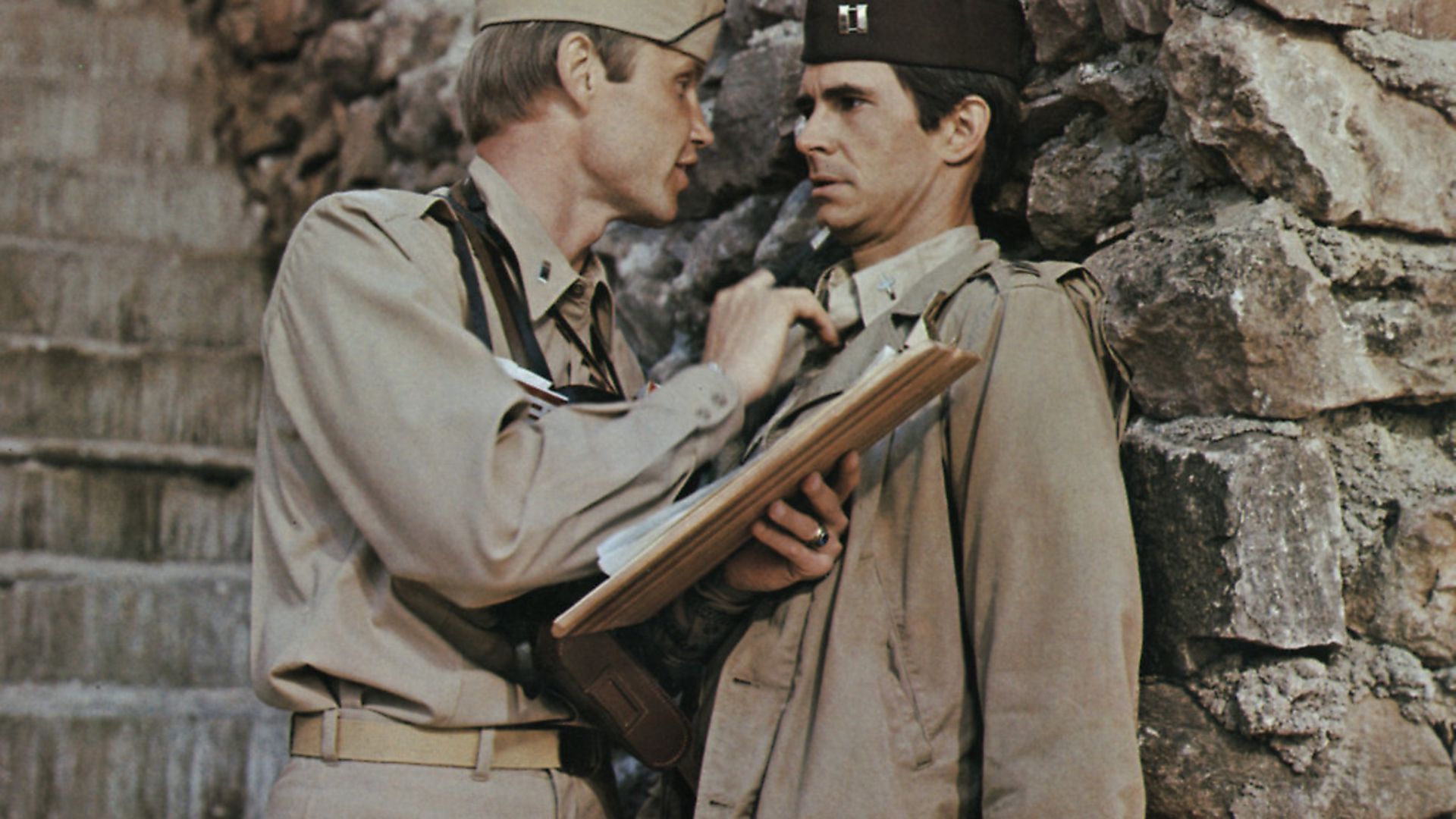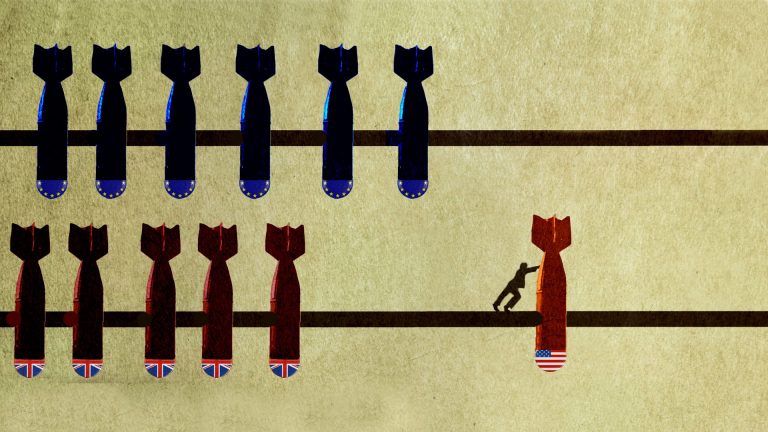
The film adaptation of Catch-22 was a colossal flop on its release 50 years ago this month. It was a wholly undeserved – if explainable – fate for a work long overdue a reappraisal, says IAN WALKER.
When the writer and polemicist Christopher Hitchens gave his autobiography the title Hitch-22 his terrible pun was a mark of respect to Joseph Heller’s novel Catch-22.
Hitchens was a Boomer, a ’68-er, one of that generation who came of age in the 1960s and did so in a spirit of radical defiance and revolt against the social order.
Catch-22, published in 1961, was part of Hitchens’ training in radical dissent. He once said that reading the book prepared him for all the ‘news from the dark frontiers of Absurdistan’. Heller’s novel described everything young Hitchens was against: war, the values of the generation before his, the relentless and dehumanising working of capital, the idiotic ways power worked, inept and self-serving bureaucracy. Most importantly of all, as a revolutionary, he was against history as something that is done to you, rather than it being something you could shape.
As a young man, Heller experienced an extreme example of history as an imposition. During the Second World War, he flew 60 missions on B25-Mitchells in the 488th Bombardment Squadron, based in the Mediterranean theatre.
Catch-22 is based on those experiences, and the book first and foremost is an anti-war novel. But it’s not an anti-war novel in the ‘war is hell’ tradition of All Quiet on the Western Front or Norman Mailer’s The Naked and the Dead. Nor is it an example of the Hemingway-esque ‘war is hell, but it teaches men about themselves’ blather – of the many stupid justifications for war masculine self-discovery is possibly the dumbest.
Instead, the book is most indebted to the Czech writer Jaroslav Hašek’s absurdist and anarchic The Good Soldier Švejk – an influence Heller acknowledged. This collection of short stories, published in the 1920s, is about the idiocy of war and bureaucracy but with both being only examples of the inherent absurdity of all existence.
As a dramatist of the madness that underpins the everyday, Hašek was a rival to his Czech contemporary Kafka. He was also funnier than Kafka, both on the page and in real life.
Hašek wrote and lived with a joyful irreverence; a will to stupidity that was an ironic counterpoint to the impositions of history. Hašek’s anarchism was both political and personal. In an attempt to settle down and put his unconventional, vagabond, flag-burning ways behind him, he once took a job writing and editing a nature and wildlife periodical. He was fired for inventing animals.
‘Catch-22’, much like ‘Kafka-esque’ and ‘Room 101’, is one of those phrases from literature, which has crossed over into common usage, but in all three examples, this common usage does not quite correspond with what the author intended.
The concept of ‘catch-22’ means more than just two irreconcilable truths, such as, say, ‘I can’t get a bus to the bank because I don’t have the bus fare. I haven’t got the bus fare because I can’t get to the bank’. In the novel, ‘catch-22’ is first used to explain the situation that Yossarian, the its anti-hero, finds himself in.
Yossarian claims that he is mad and therefore cannot fly bombing missions, but logically this cannot be true because only a sane person would not want to fly these missions. This catch then keeps cropping up in the book but does so as a description of how two conflicting, irreconcilable ideas become the form that the universe takes.
We are always trapped by the madness of it all; Yossarian is doomed to carry out insane acts because he is sane.
Hašek-like, Heller’s novel almost delights in this absurdity of existence. Nothing in the book makes sense; language becomes unhinged from meaning; the book is full of pointless arguments and ridiculous misunderstandings.
Time becomes fragmented; the book is written in a jarring, episodic way. The chronology can only be pieced together by using the ever-escalating number of missions that Colonel Cathcart demands of his crews before they can return home.
Identity shifts; Major Major Major Major exists outside of himself because of his name. A young crew member called Mudd is killed before he officially exists, Doc Daneeka is considered dead just because a report says he is. Cause and effect, common sense, identity, nationhood, time, all of these become strange and unreal in Heller’s novel.
But this is where the novel goes way beyond the emotionally-charged but usually obvious intentions of most anti-war novels. Instead, Catch-22 is an example of that almost extinct genre, the novel of ideas.
The book is a dramatisation of the bleak philosophy of the 19th century German philosopher Schopenhauer. It is about a man trying to find some sort of meaning in a universe where the irreconcilability of conflicting truths are destructive (especially so during a war), thus making alienation the natural form of existence.
Schopenhauer’s philosophy was a rejection of that of Hegel (and of Marx, which followed from Hegel), that saw two conflicting ideas as the working of progress, two contradictory ideas – the dialectic – that resolve themselves by producing something better.
Yossarian spends the novel bombing strangers while being shot at by strangers, so it is very easy to sympathise with his view that the universe is not an inherently good place and that progress is not the driving force of history. (Right now, in 2020, looking at the news cycle of the last few years, Yossarian – and Schopenhauer – still have a point. Does anyone here currently not feel as though the shaping of modern history is both absurd and an imposition?).
Heller’s book quickly found its audience. It was almost top of the reading list for the counterculture, and its success soon caught the attention of Hollywood. The film version was released 50 years ago this month.
Hopes for it were high. Here was a film about the idiocy of war released just as America was looking to extract itself from an unwinnable conflict in Vietnam. It was also a film that had all the New Hollywood credentials; it was directed by Mike Nichols, who, three years earlier, had directed The Graduate, the film which, along with Bonnie and Clyde, marked the beginning of a generational shift in Hollywood.
In 1967, Jack Warner, the last of the old Hollywood moguls, failed to halt the production of Bonnie and Clyde, a film he hated. In 1975, Steven Spielberg invented the summer blockbuster with his film, Jaws.
Between these dates, a new generation of writers, actors, producers and directors transformed not just the business of Hollywood – Warner would finally retire in 1969 – but the sort of films made within the mainstream.
This group (which included Nichols, Warren Beatty, Jack Nicholson, Robert Towne, Robert Evans, Peter Bogdanovich, Roman Polanski, Francis Ford Coppola and Martin Scorsese – it was very much a boys club) drew on influences from European and Japanese cinema; Bergman, Godard, Truffaut, Fellini, Kurosawa and so on, as well as from the golden age of the Hollywood auteur; Ford, Welles, Wilder, Hitchcock… But they also had a Year Zero attitude to film-making.
They believed themselves free to make critical, subtle, innovative, epic cinema that was more interested in art than it was in money. And the films that came out of that period were extraordinary; Bonnie and Clyde, Chinatown, Badlands, The Godfather films, The Last Picture Show.
Nichols was one of the first to start shaping the New Hollywood. The films he made before Catch-22, Who’s Afraid Of Virginia Woolf? (1966) and The Graduate (1967), were character-led films; oblique, subversive and more interested in mapping out the psychological terrain than they were conjuring up happy endings. Cinematically, Nichols had the measure of the mood of the age.
And that oblique, subversive approach to cinema began with the casting of Catch-22. In what was a fractured reversal of Psycho, Anthony Perkins was cast as a priest, often appearing in scenes opposite Martin Balsam – the private investigator in Alfred Hitchcock’s film – as Catch-22’s psychotic commanding officer Colonel Cathcart.
Comedian Bob Newhart was perfect as Major Major Major Major, a man who, because of his absurd name, lives life at an awkward angle. Orson Welles turns up in the film as a high-ranking general; his performance is deranged, compelling and magisterial, which is not entirely unlike his status in film history.
And the film also cast Art Garfunkel, who, while not being quite counterculture, appeared on behalf of pop music. Nichols’ and Simon and Garfunkel’s careers were already closely entwined, with the latter’s memorable contribution to the soundtrack for The Graduate. Both musicians were originally cast in Catch-22, but the film’s screenwriter, Buck Henry, decided that Paul Simon’s role should be cut. Garfunkel was then so busy making Catch-22 that his partner was left alone in the studio in Manhattan while they should have been recording the LP Bridge over Troubled Water.
Simon wrote a song about it, The Only Living Boy in New York, and after the album was finally recorded the duo – who had been childhood friends – split up.
Other casting decisions placed the film firmly within the New Hollywood. Jon Voight, playing the black market capitalist entrepreneur Milo Minderbinder, brought to this amoral, absurd character the same guileless innocence that he bought to the gay hustler Joe Buck in John Schlesinger’s film Midnight Cowboy.
Catch-22 also featured a young Martin Sheen in a supporting role as Dobbs, his brooding and menacing appearance – along with his spectacular quiff – often threatening to dominate scenes in which he featured. Three years later, Sheen would play the lead role in Terrence Malik’s Badlands, a troubling film where nature manifests itself as indifferent to the awful ways of man. It is one of the high points of the New Hollywood and Sheen’s Badlands version of James Dean reimagined as a dead-eyed monster – all perfect manners and cold stares – can be traced back to something found in Dobbs in Catch-22.
And there’s Alan Arkin, in the lead role of Yossarian, the disillusioned bombardier, who is too critical, too smart, too given over to the examined life, to want to keep flying bombing missions. Arkin is pitch-perfect in how he plays the role.
Yossarian is no coward. Instead, he just sees the absurdity of military life, and perhaps all life, too clearly. Yossarian just about manages to keep his despair in check with a mixture of irony and sly rebellion. Throughout the film we watch Arkin as he, in turn, watches the awful inevitability of events around him: the death of friends, the constant raising of the number missions he has to fly, the pointless raids, the bombing of civilians, the ambition of officers, the ridiculous accidents.
As all this unfurls about him, he doesn’t quite break the fourth wall, or look at the camera, or wink at us, but he is always on the edge of doing that, of trying to escape the film, of thinking his way out of it all so as to join us happy punters on this side of the camera.
So, with the film of Catch-22 we have a wonderful blend: perfect timing, a fascinating cast, a brilliant director, one of the great novels of the age as source material. Yet it flopped at the box office, and the critical reviews were mixed.
Why?
There was one obvious reason. A few months earlier, the anti-war, black comedy M*A*S*H*. had been released. Based on the memoirs of Richard Hornberger, a medical surgeon who served in Korea, the film, directed by one of the greats of the New Hollywood, Robert Altman, was a hit.
The film of Catch-22 is heavier going than M*A*S*H*. Yossarian is too uptight and too earnest ever to display the easy-going, subversive charisma of Hawkeye and Trapper.
Whereas M*A*S*H*. is a funny anti-war film, Catch-22 is a dark satire on war and the absurdity of existence. The former has charm, while the latter is uncomfortable.
It’s obvious why Altman’s film eclipsed Nichols’, and why one produced an incredibly successful small screen spin-off, whereas the other didn’t (a 1973 television version of Catch-22 never got past the pilot stage).
A second reason why the film flopped was because of the nature of the war being satirised. M*A*S*H* was about Korea, but everyone got that it was really about Vietnam, an unpopular conflict which America was losing. Catch-22 was about the Second World War.
Even if you are anti-war, it’s hard to argue that war was not essentially a necessary one, of good against evil. There are times when Yossarian seems oblivious to the magnitude of what he is fighting against.
The most recent screen adaptation of Catch-22, a television series released last year, co-produced, co-starring and co-directed by George Clooney, is more in the spirit of depicting the conflict as the United States’ heroic stand against fascism. The absurdity of war and the ineptitude of officers are still part of this adaptation, but it is tempered by a Band of Brothers-type framing of the story, which is told chronologically and begins in a training camp, something which is not there in Heller’s novel.
Clooney’s version is well made (and looks fantastic) and raises questions that are partly absent in Heller’s novel, questions about good versus evil. As such, it acts as a highly entertaining extensive footnote, an essay even, about the original novel.
The third reason why the 1970 production flopped is to do with that original novel. A feature of the New Hollywood was that the Old Hollywood was baffled by the cultural shifts of the 1960s. Lost in a political terrain they didn’t understand, they tended to green-light projects that wouldn’t normally get anywhere near production. A good example is the not-entirely-bad hippy indulgence of Peter Fonda and Dennis Hopper’s Easy Rider. A better example is the follow-up that Hopper made, The Last Movie, where Hollywood paid him to disappear into the Peruvian jungle with a load of drugs. He reappeared much later with a film about appearance versus reality, about the nature of art, it starred his mates, it now has cult status. It’s garbage.
The studios would always have been interested in the best-selling novel Catch-22’s commercial success. But in those free-wheelin’ late-1960s, open-minded, Peruvian drug-binge days, the studios could just as easily have green-lit a film which was pitched as ‘Schopenhauer’s philosophy as a critique of Hegelian idealism as reimagined in the lives of US bombing crews during the Second World War’.
Of course, as a tagline on a poster, this is not quite up there with ‘In space, no-one can hear you scream’ or ‘Who you gonna call…?’. A ‘Schopenhauer vs Hegel’ tagline may well have sold the film to me, but probably not many others.
And perhaps that was the main reason why it was a commercial failure. Nichols stuck closely to the source material, with all its bleak difficulties. But in doing so, he produced a challenging and demanding work.
One of the defining features of the New Hollywood was that it was influenced by European cinema. At that time, Godard was questioning what cinema could and couldn’t do. How does it tell stories? How does it mimic time? How does it relate to the written word? And Fellini was also taking apart the language of cinema as he attempted to place a dreamlike psychological subjectivity on the screen.
Nichols’ film is in this tradition. It’s an art-house banger. The film revels in the language and techniques of cinema, the editing of time and space, to stick, albeit loosely, to Heller’s original text.
Nichols creates an unreal cinematic world in which Arkin as Yossarian pushes back against reality and also against the rules of cinema. He is trying to find the best way to live in a world that makes no sense, that usurps beauty, that is indifferent to human life. And Nichols is looking for the best way to film that.
The film’s opening shot is of an idyllic Mediterranean sunrise whose beauty is then shattered by the raw growl of the radial engines of the B-25s. Later we see an extended, complicated, tracking shot involving those B-25s trundling around the protagonists as they play out their tiny little human drama. This scene; light, movement, dialogue, nature, noise and tension, is pure cinema.
Another scene, where Milo Minderbinder goes into commercial partnership with the Luftwaffe and organises the bombing of his own base, is full of fire and silhouettes, a sort of terrible beauty not unlike the imagery used a decade later by Coppola in Apocalypse Now.
Towards the end of the film, Yossarian finds himself unhinged from all reality, as he makes his way through Roman streets that are full of dreamlike imagery, images that are drawn from Fellini and Dostoevsky, and from the mess of human desires and motives.
Again, this is cinema at its best, at times it feels literary, at other times it is like fine art, there is a storyline involved, but this scene is really about how Yossarian thinks and feels as he moves through space and time. Cinematically, the film is Nichols at the height of his powers.
So, the Catch-22 film flopped because it was overshadowed by M*A*S*H*. It was also a film too critical of a noble war to achieve broad success. And it was too tied to complex philosophical debates rooted in 19th century German philosophy to ever be that heavy on the LOLs.
As such, Catch-22 is generally regarded as being a film that failed, and so never gets placed in the canon of the New Hollywood greats. But it should be in that canon. It is a cinematic masterpiece made with wit and intelligence. Not only does it do justice to one of the great novels of the last century, but it is also a compelling, original film that gets stuck into questions about war, about cinema, and about fundamental philosophical questions about us and nature and the universe.








